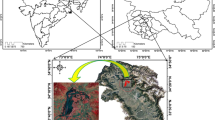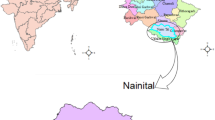Abstract
Area statistics of large lakes is the most concerned primary indicator in existing studies of freshwater ecosystem (FE) dynamics in watershed-dominated regions (WDRs). However, large lakes alone cannot represent the complete status of WDRs, and the dynamic changes of some smaller water types, such as rivers, pits, and streams, need to be given more attention. In order to capture more refined spatiotemporal features of multiple FE types and provide important basis of FE management, multi-temporal high spatial resolution remote sensing images (< 5 m) were used to capture more detailed FE information and change tendencies in Jianghuai Ecological and Economic Zone (JHEEZ). Despite that the general change of total FE area was less than 5% from 2015 to 2018, even though the change in lake areas was only 0.12%, some different and interesting findings can be observed from different FE types and their shapes. First, different lakes exhibited different change features. Hongze Lake, which is the largest lake in JHEEZ, remained stable in the last three years, while some relatively small lakes, such as Gaoyou Lake and Baima Lake, demonstrated much more dynamic and complicated transformations, especially represented in the locally-variations of lake shorelines. In particular, both notable transfer in (polder areas changed into lakes) and transfer out (areas occupied by construction land and forestland) features could be observed in Baima Lake, which was driven by integrated roles of the ‘retreating to lakes’ project and tourism development. Second, small ponds represent the most significant increasing tendency. More than 500 km2 of new ponds were observed, in which more than 80% were transferred from arable land. These new pond regions were mainly located in the lake storage area and in the suburbs of major cities. All of these findings indicate that, the sub-types of FE that have small areas and scattered distribution features are more likely to undergo more dynamic changes than those of large lakes. Therefore, in addition to the dynamics changes of large lakes and their boundaries, this study also contributes to a deeper understanding of multiple small FE types. Furthermore, it is beneficial to more accurate freshwater resources management.






Similar content being viewed by others
Data Availability
Some or all data, models, or code generated or used during the study are available from the corresponding author by request.
References
Behnam D, Andrea B, Dirk R, Elisa AC, Pietro F, Mario S, Gianluca B (2017) Patterns of streamflow regimes along the river network: The case of the Thur river. Environ Model Softw 93:42–58
Bhatta LD, van Oort BE, Helmuth, Stork NE, Baral, Himlal (2015) Ecosystem services and livelihoods in a changing climate: understanding local adaptations in the Upper Koshi, Nepal. Int. J. Biodivers Sci Ecosyst Serv Manag (April):1–11
Biggs J (2008) Carbon uptake by UK ponds. Pond Conservation for Life in Freshwater. May 6, 2008. Oxford, UK
Boelee E (2013) Managing water and agro ecosystems for food security. Comprehensive Assessment of Water Management in Agriculture Series. CABI, Wallingford
Chen J, Chen J, Liao A, Cao X, Chen L, Chen X, He C, Han G, Peng S, Lu M (2015) Global land cover mapping at 30 m resolution: A POK-based operational approach. ISPRS J Photogram Remote Sens 103:7–27
Chen WJ, He B, Nover D, Lu HM, Liu J, Sun W, Chen W (2019) Farm ponds in southern China: Challenges and solutions for conserving a neglected wetland ecosystem. Sci Total Environ 659:1322–1334
Cihlar J (2000) Land cover mapping of large areas from satellites: Status and research priorities. Int J Remote Sens 21:1093–1114
Cole JJ, Prairie YT, Caraco NF, McDowell WH, Tranvik LJ, Striegl RG, Duarte CM, Koterlainen P, Downing JA, J. M. Melack. 2007. Plumbing the global carbon cycle: Integrating inland waters into the terrestrial carbon budget. Ecosystems 10:171–184
Daggupati P, Shukla R, Mekonnen B, Rudra R, Biswas A, Goel PK, Prasher S, Yang W (2018) Hydrological responses to various land use, soil and weather inputs in Northern Lake Erie Basin in Canada. Water 10:222
Davidson NC (2014) How much wetland has the world lost? Long-term and recent trends in global wetland area. Mar Freshwater Res 65:934–941
Downing JA (2010) Emerging global role of small lakes and ponds: Little things mean a lot. Limnetica 29:9–24
Downing JA, Duarte CM (2009) Abundance and size distribution of lakes, ponds, and impoundments. In: Likens GE (ed) Encyclopedia of Inland Waters. Elsevier, Oxford, pp 469–478
Downing JA, Prairie YT, Cole JJ, Duarte CM, Tranvik LJ, Striegl RG (2006) The global abundance and size distribution of lakes, ponds, and impoundments. Limnol Oceanogr 51:2388–2397
Español C, Gallardo B, Comín FA, Pino MR (2015) Constructed wetlands increase the taxonomic and functional diversity of a degraded floodplain. Aquat Sci 77:27–44
Fang CL, Zhou CH, Wang ZB (2015) Sustainable development strategy and priorities of spatially differentiated development of urban agglomerations along the Yangtze River Economic Belt. Progress Geogr 34:1398–1408
Gong P (2012) Remote sensing of environmental change over China: A review. Chin Sci Bull 57:2793–2801
Grippa M, Rouzies C, Biancamaria S, Blumstein D, Cretaux JF, Gal L, Robert E, Gosset M, Kergoat L (2019) Potential of SWOT for monitoring water volumes in Sahelian ponds and lakes. IEEE J Sel Top Appl Earth Obs Remote Sens 12:2541–2549
Grobicki A, Chalmers C, Jennings E, Jones T, Peck D (2016) An introduction to the ramsar convention on wetlands (previously The Ramsar Convention Manual). Ramsar Convention Secretariat, Gland
Guillon P, Thorel M, Nicolas F, Oursel B, Claret C, Fayolle S, Bertrand C (2019) Functional classification of artificial alluvial ponds driven by connectivity with the river: Consequences for restoration. Ecol Eng 127:394–403
Herve Y, Claire H, Lai XJ, Stephane A, Li JR, Sylviane D, Muriel BN, Chen XL, Huang SF (2011) Nine years of water resources monitoring over the middle reaches of the Yangtze River, with ENVISAT, MODIS, Beijing-1 time series, Altimetric data and field measurements. Lakes Reserv 16(3):231–247
Hill MJ, Hassall C, Oertli B, Fahrig L, Robson BJ, Biggs J, Samways MJ, Usio N, Takamura N, Krishnaswamy J, Wood PJ (2018) New policy directions for global pond conservation. Conserv Lett 22:e12447
Holzmann S, Puhlmann H, Wilpert K (2016) Impact of anthropogenic induced nitrogen input and liming on phosphorus leaching in forest soils. J Plant Nutr Soil Sci 18:17876–17453
Huq N, Bruns A, Ribbe L (2019) Interactions between freshwater ecosystem services and land cover changes in southern Bangladesh: A perspective from short-term (seasonal) and long-term (1973–2014) scale. Sci Total Environ 650(2019):132–143
IPCC (2014) Summary for policymakers. In: Field CB, Barros VR, Dokken DJ, Mach KJ, Mastrandrea MD, Bilir TE, Chatterjee M et al Climate Change 2014: impacts, Adaptation, and Vulnerability. Part A: Global and Sectoral Aspects. Contribution of Working Group II to the Fifth Assessment Report of the Intergovernmental Panel on Climate Change. Cambridge University Press, Cambridge, pp 1–32
Lehner B, Doll P (2004) Development and validation of a global database of lakes, reservoirs and wetlands. J Hydrol 296:1–22
Lennon J, Davis K (2019) Cultural landscape protection at Lake Victoria, a managed water supply. Landscape Research. https://doi.org/10.1080/01426397.2019.1626356
McDonald CP, Rover JA, Stets EG, Striegl RG (2012) The regional abundance and size distribution of lakes and reservoirs in the United States and implications for estimates of the global lake extent. Limnol Oceanogr 57:597–606
Moussaid J, Fora AA, Zourarah B, Maanan M, Maanan M (2015) Using automatic computation to analyze the rate of shoreline change on the Kenitra coast Morocco. Ocean Eng 102:71–77
Mu HQ (2018) A review on scientific researches of water resources protection in Yangtze River Basin. J Yangtze River Sci Res Inst 35(4):1–5 ((in Chinese)
Sadeghian A, Boer DD, Lindenschmidt KE (2017) Sedimentation and erosion in Lake Diefenbaker, Canada: solutions for shoreline retreat monitoring. Environ Monit Assess 189:507–520
Seekell DA, Pace LJ (2011) Does the Pareto distribution adequately describe the size-distribution of lakes? Limnol Oceanogr 56:350–356
Seekell DA, Pace ML, Tranvik LJ, Verpoorter C (2013) A fractal-based approach to lake size-distributions. Geophys Res Lett 40:517–521
Thorel M, Piégay H, Barthelemy C, Räpple B, Gruel C-R, Marmonier P, Winiarski T, Bedell J-P, Arnaud F, Roux G, Stella JC, Seignemartin G, Tena-Pagan A, Wawrzyniak V, Roux-Michollet D, Oursel B, Fayolle S, Bertrand C, Franquet E (2018) Socio-environmental implications of process-based restoration strategies in large rivers: should we remove novel ecosystems along the Rhône (France)? Reg. Environ Chang 18:2019–2031
Verhoeven JT, Arheimer B, Yin C, Hefting MM (2006) Regional and global concerns over wetlands and water quality. Trends Ecol Evol 21:2, 96–103
Verpoorter C, Kutser T, Tranvik L (2012) Automated mapping of water bodies using Landsat multispectral data. Limnol Oceanogr Methods 10:1037–1050
Verpoorter C, Kutser T, Seekell DA, Tranvik LJ (2014) A global inventory of lakes based on high-resolution satellite imagery. Geophys Res Lett 41:6396–6402
Vivek G, Santonu G, Samal RN, Choudhury SB (2019) Monitoring of Chilika Lake mouth dynamics and quantifying rate of shoreline change using 30 m multi-temporal Landsat data. Data Brief 22:595–600
Vörösmarty CJ, McIntyre PB, Gessner MO, Dudgeon D, Prusevich A, Green P, Glidden S, Bunn SE, Sullivan CA, Liermann CR, Davies PM (2010) Global threats to human water security and river biodiversity. Nature 468:334–334
Wang DM, Liu JS, Dai XL, Wang CM (2017) Study on long-term effective mechanism of returning polder (fields) to lake(wetland). Yangtze. 48(18):23–26
Wang YH, Wang DM, Liang YG, Gao SP (2019) Application of 3S technology in the retirement Lake in Jiangsu Province. Water Conservancy Hydropower Express 40(4):63–67 (in Chinese)
Wickham J, Stehman SV, Gass L, Dewitz JA, Sorenson DG, Granneman BJ, Poss RV, Baer LA (2017) Thematic accuracy assessment of the 2011 National Land Cover Database (NLCD). Remote Sens Environ 191:328–341
Yang YY, Liu WZ, Xu C, Wei BQ, Wang J (2017) Antibiotic resistance genes in lakes from middle and lower reaches of the Yangtze River, China: Effect of land use and sediment characteristics. Chemosphere 178:19–25
Yu YH, Yu MM, Lin L, Chen JX, Li DJ, Wang WT, Cao K (2019) National green GDP Assessment and prediction for China based on a CA-markov land use simulation model. Sustainability 11:576
Zhao QG, Huang GQ, Ma YQ (2016) The ecological environment conditions and construction of an ecological civilization in China. Acta Ecol Sin 36:19. 6328–6335
Zhu X, Zhu Q (2018) Researches on assessment of ecosystem service function of Baima Lake. Environ Sci Manag 9:153–157 (in Chinese)
Zhuo HH, Shen RY, Wang RL, Lan J, Zhai WY, Ouyang XJ, Zang XP (2019) Evaluation and trend analysis on water resources quality of Yangtze River Basin. Yangtze River 50(2):122–112 (in chinese)
Acknowledgments
The work was funded by The National Natural Science Foundation of China (Grant No. 41671284) and Key Research Plans of Frontier Sciences, Chinese Academy of Sciences (QYZDB-SSW-DQC038). Data were supported by Scientific Data Sharing Platform for Lake and Watershed, Nanjing Institute of Geography and Limnology, Chinese Academy of Sciences.
Author information
Authors and Affiliations
Corresponding authors
Additional information
Publisher's Note
Springer Nature remains neutral with regard to jurisdictional claims in published maps and institutional affiliations.
Rights and permissions
About this article
Cite this article
Lin, C., Cheng, H., Zhang, C. et al. Using High-resolution Remote Sensing Images to Detect Freshwater Ecosystem Changes – a New Perspective of Different Ecosystem Types and Shapes. Water Resour Manage 34, 3565–3584 (2020). https://doi.org/10.1007/s11269-020-02636-y
Received:
Accepted:
Published:
Issue Date:
DOI: https://doi.org/10.1007/s11269-020-02636-y




